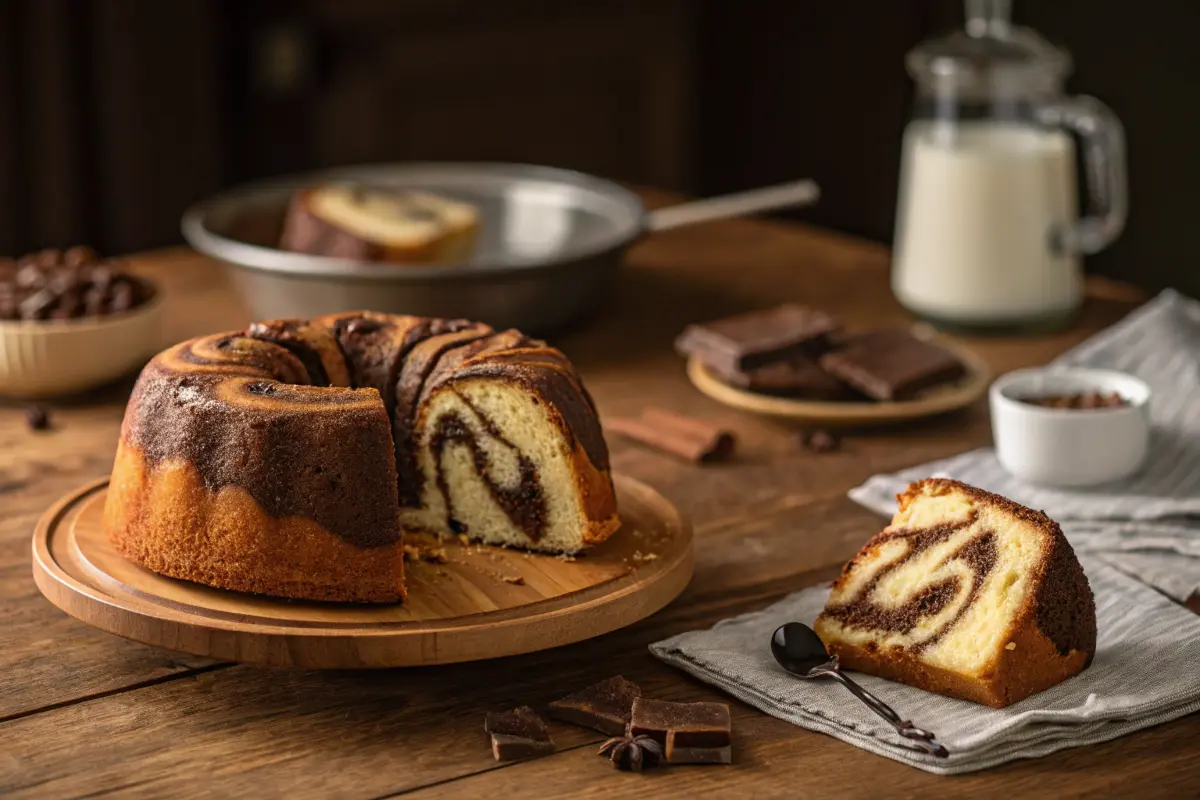Introduction
Few cakes are as visually stunning and delicious as a marble cake. With its beautiful swirls of chocolate and vanilla, this cake is a perfect blend of flavors, making it a favorite for both casual bakers and professionals. Originating in Germany, marble cake has evolved over the years, now coming in various styles—from pound cakes to airy sponge cakes.
In this in-depth guide, we’ll cover everything you need to know about marble cake, from its history and key ingredients to step-by-step instructions on how to make the best version at home. We’ll also explore common mistakes, the best toppings, and creative variations you can try. Whether you’re a beginner or an experienced baker, this guide will help you perfect your marble cake every time.
What is Marble Cake?
The Origin of Marble Cake
The history of marble cake dates back to 19th-century Germany, where it was originally called Marmorkuchen. Early versions of this cake featured light and dark batters swirled together, often flavored with molasses, spices, and dried fruits instead of chocolate. German immigrants later brought this recipe to America, where it evolved into the classic chocolate and vanilla marble cake we love today.
Traditional vs. Modern Marble Cake
Originally, marble cake was a simple blend of two contrasting batters, sometimes flavored with coffee, nuts, or honey. Today, bakers experiment with different flavors, from red velvet and vanilla to matcha and chocolate. The most popular modern version remains the vanilla and chocolate marble cake, typically made with butter, sugar, eggs, flour, and cocoa powder for the chocolate swirl.
Why is it Called Marble Cake?
The name marble cake comes from its signature swirled appearance, which resembles natural marble stone. This effect is achieved by layering and gently swirling the two batters before baking. The technique not only creates a visually appealing dessert but also ensures each bite has a perfect balance of flavors.
Key Ingredients for Marble Cake
A perfect marble cake starts with high-quality ingredients that ensure the right balance of flavor and texture. Whether you’re making a classic chocolate and vanilla marble cake or experimenting with unique variations, selecting the best ingredients is crucial.
Essential Ingredients: Flour, Sugar, Butter, and Eggs
The foundation of any marble cake is a well-balanced combination of dry and wet ingredients:
- Flour – All-purpose flour is commonly used, but for a lighter texture, you can substitute some with cake flour.
- Sugar – Granulated sugar adds sweetness while also helping with moisture retention. Some bakers mix in brown sugar for extra richness.
- Butter – Unsalted butter is preferred, as it allows better control over the cake’s flavor. It also contributes to a tender crumb.
- Eggs – Eggs provide structure and stability. Using an extra yolk can make the cake richer and more tender.
The Role of Dairy: Milk, Sour Cream, or Buttermilk?
The choice of dairy affects the cake’s texture and moisture content:
- Milk – Standard in many recipes, but it can be swapped for buttermilk for extra tenderness.
- Sour Cream – Adds moisture and a slight tang, resulting in a moist marble cake with a fine crumb.
- Buttermilk – The acidity in buttermilk reacts with baking soda, leading to a softer texture and enhanced flavor.
Chocolate in Marble Cake: Cocoa Powder vs. Melted Chocolate
The chocolate swirl in marble cake can be created in two ways:
- Cocoa Powder – Easier to mix in and provides a deep, rich cocoa flavor.
- Melted Chocolate – Results in a more intense chocolate taste and denser texture.
Now that we’ve covered the essential ingredients, let’s move on to how to make the perfect marble cake!
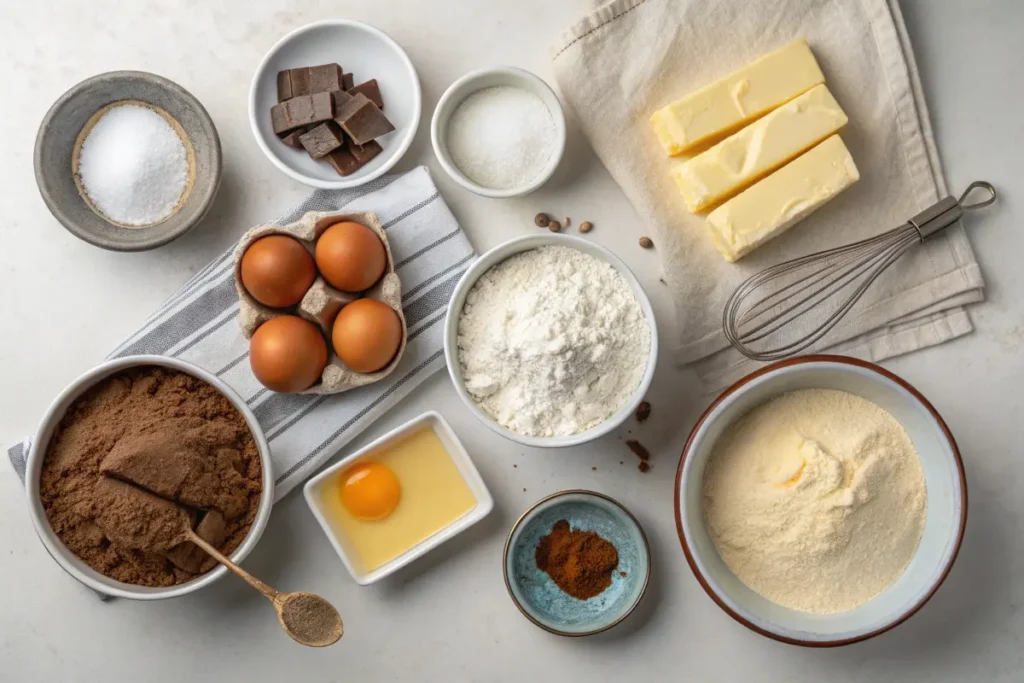
How to Make Marble Cake – Step-by-Step Recipe
Making a marble cake may seem complicated, but with the right technique, it’s simple and rewarding. Follow these steps to create a beautifully swirled, moist marble cake.
Preparing the Vanilla Batter
- Cream the Butter and Sugar – Beat softened butter and sugar until light and fluffy, about 3–5 minutes. This step ensures a tender cake.
- Add Eggs and Vanilla Extract – Mix in eggs one at a time, ensuring each is fully incorporated. Then, add vanilla extract for enhanced flavor.
- Alternate Dry and Wet Ingredients – Gradually mix in the sifted flour, baking powder, and salt, alternating with the milk or sour cream. Mix until just combined to avoid overworking the batter.
Creating the Chocolate Batter
- Prepare Cocoa Mixture – If using cocoa powder, mix it with hot water or milk to “bloom” the cocoa, enhancing its flavor.
- Divide the Batter – Separate about one-third of the vanilla batter and mix in the prepared cocoa mixture or melted chocolate.
Swirling Technique: How to Achieve the Perfect Marbling
- Layer the Batters – Spoon alternating scoops of vanilla and chocolate batter into a greased cake pan.
- Swirl with a Knife – Gently drag a butter knife or skewer through the batter in a figure-eight motion to create a marbled effect. Avoid over-mixing, or the swirls will blend too much.
Baking Tips for a Moist and Fluffy Cake
- Preheat the Oven – Bake at 350°F (175°C) for even cooking.
- Check for Doneness – Insert a toothpick in the center; if it comes out clean, the cake is ready.
- Let It Cool – Allow the cake to cool in the pan for 10 minutes before transferring it to a wire rack.
Now, you’re ready to enjoy a homemade marble cake! Up next, we’ll explore the different types of marble cake. Stay tuned!
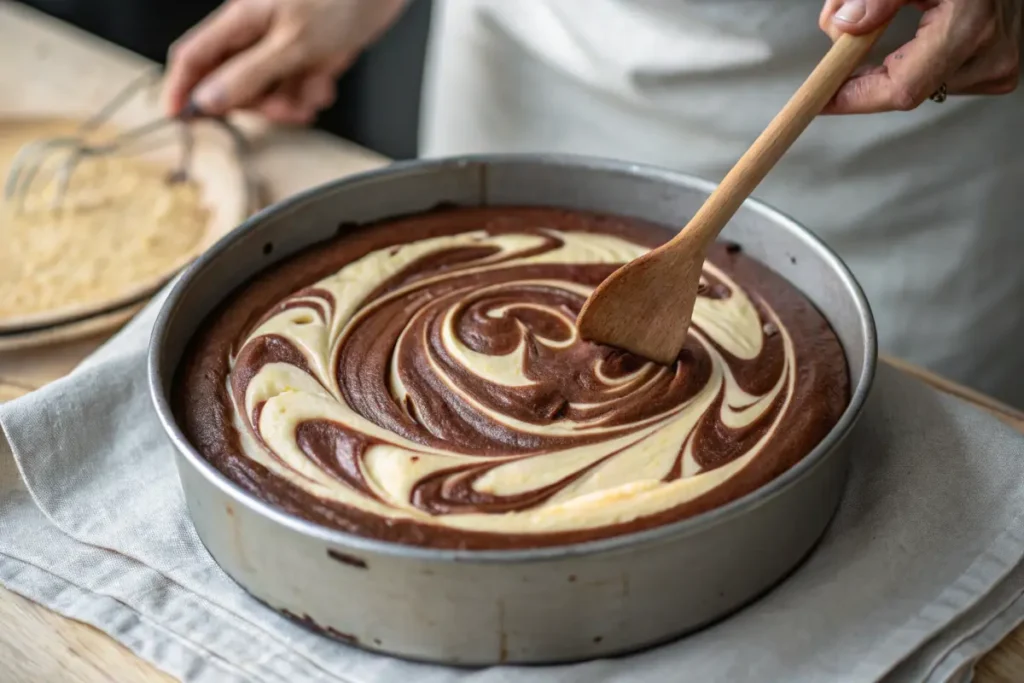
Different Types of Marble Cake
While the classic chocolate and vanilla marble cake remains a favorite, there are many variations that introduce exciting flavors and textures. Whether you prefer a dense, buttery pound cake or a light and airy sponge, there’s a marble cake for everyone!
Classic Vanilla and Chocolate Marble Cake
This is the most traditional version, featuring a moist vanilla cake swirled with a rich chocolate batter. It’s often baked as a loaf, bundt, or layer cake and can be topped with powdered sugar, glaze, or ganache. The key to its success is balancing the flavors so that both chocolate and vanilla shine equally.
Marble Pound Cake vs. Marble Sponge Cake
Not all marble cakes have the same texture. Here’s how they differ:
- Marble Pound Cake – Denser and richer due to a high butter and egg content. This cake is perfect for slicing and pairs well with coffee or tea.
- Marble Sponge Cake – Lighter and fluffier, thanks to whipped eggs or baking powder. This version is great for layered cakes with frosting.
Vegan and Gluten-Free Marble Cake Options
For those with dietary restrictions, you can still enjoy a delicious marble cake!
- Vegan Marble Cake – Uses plant-based milk, coconut oil, and flaxseed or applesauce as an egg substitute.
- Gluten-Free Marble Cake – Made with almond flour, oat flour, or a gluten-free blend to maintain a tender crumb.
No matter your preference, these variations ensure that marble cake remains a versatile and crowd-pleasing dessert.
Common Mistakes and How to Fix Them
Even experienced bakers can run into issues when making marble cake. Below are some common mistakes and tips to ensure success every time.
Why is My Marble Cake Dry?
A dry marble cake is often caused by:
- Overbaking – Always check for doneness with a toothpick. If it comes out with a few moist crumbs, the cake is ready.
- Too Much Flour – Measure using a scale or spoon-and-level method to avoid adding excess flour.
- Lack of Moisture – Ingredients like sour cream, buttermilk, or yogurt can keep the cake soft and tender.
How to Get a More Pronounced Chocolate Flavor
Sometimes, the chocolate swirl lacks depth. Here’s how to fix it:
- Use Melted Chocolate – Instead of just cocoa powder, mix in melted dark chocolate for a richer taste.
- Bloom the Cocoa Powder – Mixing cocoa with hot water enhances its flavor before adding it to the batter.
- Add Espresso Powder – A small pinch of espresso powder can intensify the chocolate notes without making the cake taste like coffee.
Preventing Sinking or Uneven Marbling
If your swirls sink or don’t mix well, try these tips:
- Balance the Batters – The vanilla and chocolate batters should have similar consistencies to avoid sinking.
- Don’t Over-Swirl – Gently drag a knife through the batter to create a marble effect without fully mixing the colors.
- Use the Right Baking Pan – A light-colored metal pan ensures even baking, preventing one part from cooking faster than the other.
Best Toppings and Frostings for Marble Cake
A well-made marble cake is delicious on its own, but the right topping can take it to another level. Whether you prefer a simple glaze or a decadent frosting, here are the best options to enhance your marble cake.
Chocolate Ganache: The Ultimate Pairing
If you love chocolate, a silky ganache is the perfect way to elevate your marble cake.
- How to Make It – Simply heat heavy cream and pour it over chopped dark chocolate. Stir until smooth, then drizzle over the cake.
- Why It Works – Ganache adds richness while keeping the cake moist. Plus, it enhances the chocolate swirls for a deeper flavor.
Vanilla Buttercream vs. Cream Cheese Frosting
Choosing the right frosting depends on your preference for sweetness and texture.
- Vanilla Buttercream – A classic choice that’s light, fluffy, and easy to spread. It adds a hint of sweetness without overpowering the cake.
- Cream Cheese Frosting – Slightly tangy and creamy, this pairs well with marble cake, balancing its sweetness.
Simple Sugar Glaze for a Bakery-Style Look
For a minimalist approach, a simple glaze works wonders.
- How to Make It – Mix powdered sugar with milk or lemon juice until smooth, then pour over the cake.
- Best for Loaf Cakes – A sugar glaze gives marble cake a glossy finish and adds just the right touch of sweetness.
No matter which topping you choose, these options make your marble cake even more irresistible!
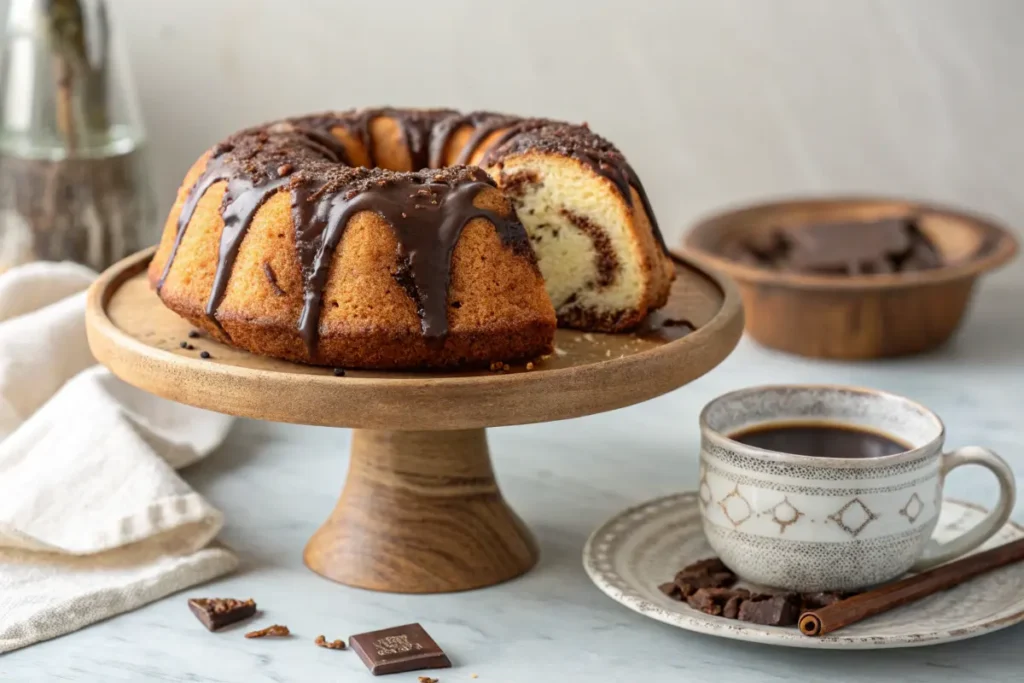
Creative Variations of Marble Cake
Why stick to the classic chocolate and vanilla marble cake when there are so many exciting variations to try? Experimenting with flavors can make your marble cake even more unique and delicious.
Strawberry and Chocolate Marble Cake
For a fruity twist, swap the vanilla batter for a strawberry-flavored one.
- How to Make It – Blend fresh strawberries into the vanilla batter or use strawberry extract for a bold flavor.
- Best Toppings – A drizzle of white chocolate or a dusting of powdered sugar complements the fruity notes.
Coffee and Vanilla Marble Cake
Coffee lovers will enjoy this sophisticated version, where coffee adds depth to the swirls.
- How to Infuse Coffee Flavor – Dissolve instant espresso powder in warm milk and mix it into the chocolate batter.
- Why It Works – The coffee intensifies the chocolate flavor while adding a subtle bitterness that balances the sweetness.
Marble Bundt Cake with Caramel Drizzle
A bundt cake version adds elegance to the classic recipe, making it perfect for special occasions.
- Baking Tip – Use a well-greased bundt pan to ensure the cake releases cleanly.
- Topping Suggestion – A rich caramel drizzle enhances the cake’s texture and flavor
FAQs
Many bakers have questions about marble cake, from keeping it moist to finding the best substitutes. Here are answers to the most common queries.
How do I make my marble cake more moist?
A dry marble cake can be disappointing, but a few simple tweaks can help:
Use sour cream or buttermilk – These ingredients add moisture and a slight tang that enhances the cake’s flavor.
Don’t overmix the batter – Overworking the flour can make the cake dense and dry. Mix just until combined.
Check baking time – Overbaking is a common mistake. Start checking the cake a few minutes before the suggested time.
Can I use oil instead of butter in marble cake?
Yes! Using oil instead of butter can make marble cake even softer.
Why use oil? – Oil keeps cakes moist for longer since it doesn’t solidify like butter when cooled.
Best choices – Vegetable oil or a mild olive oil works best. You can replace half or all of the butter with oil for a lighter texture.
What’s the best way to store marble cake?
To keep marble cake fresh:
Store at room temperature – Keep it in an airtight container for up to 3 days.
Refrigerate for longer storage – Wrap the cake in plastic wrap and refrigerate for up to a week.
Freeze for future enjoyment – Slice the cake and freeze individual pieces for up to 3 months.
Can I make marble cake without eggs?
Yes! Try these egg substitutes:
Applesauce – Adds moisture without affecting the flavor.
Mashed bananas – Works well but adds a subtle banana taste.
Flaxseed meal – Mix 1 tablespoon of flaxseed with 3 tablespoons of water to replace one egg.
Conclusion – The Joy of Baking Marble Cake
Baking a marble cake is both an art and a science. The delicate balance of vanilla and chocolate, the mesmerizing swirls, and the endless variations make it a timeless favorite. Whether you’re making a rich marble pound cake, a fluffy sponge version, or experimenting with flavors like strawberry or coffee, there’s no limit to the creativity you can bring to this classic dessert.
By following the right techniques—choosing quality ingredients, mastering the swirling method, and avoiding common baking mistakes—you can create a marble cake that’s moist, flavorful, and visually stunning. And with the best toppings, from chocolate ganache to a simple sugar glaze, you can make your cake even more irresistible.
So, what are you waiting for? Whether you’re baking for a family gathering, a special celebration, or just a personal treat, a homemade marble cake is always a great idea. Try out different variations, experiment with textures, and most importantly, enjoy the process!
Happy baking! 🍰
👉 For more delicious dessert ideas, check out this Cherry Pineapple Dump Cake Recipe.
Print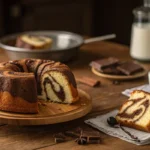
The Ultimate Guide to Marble Cake – A Perfect Swirl of Flavor
- Total Time: 55 minutes
- Yield: 8 servings 1x
- Diet: Vegetarian
Description
A soft and moist marble cake with beautiful swirls of chocolate and vanilla. This easy recipe is perfect for home bakers who want a delicious and visually stunning dessert.
Ingredients
- 2 cups all-purpose flour
- 1 cup sugar
- 1/2 cup butter, softened
- 3 eggs
- 1 cup milk
- 1 tsp vanilla extract
- 2 tbsp cocoa powder
- 1 tsp baking powder
- 1/4 tsp salt
Instructions
- Preheat oven to 350°F (175°C) and grease a loaf pan.
- In a bowl, mix flour, baking powder, and salt.
- In another bowl, cream butter and sugar until light and fluffy.
- Add eggs one at a time, then stir in vanilla.
- Alternately add the dry ingredients and milk to the batter, mixing gently.
- Divide batter into two bowls. Add cocoa powder to one and mix.
- Pour both batters into the pan, alternating scoops. Swirl with a knife for the marbled effect.
- Bake for 40 minutes, or until a toothpick comes out clean.
- Let the cake cool before slicing and serving.
- Prep Time: 15 minutes
- Cook Time: 40 minutes
- Category: Breakfast
- Cuisine: American
Nutrition
- Calories: 320 kcal
- Sugar: 25g
- Fat: 12g
- Saturated Fat: 7g
- Carbohydrates: 45g
- Protein: 5g

